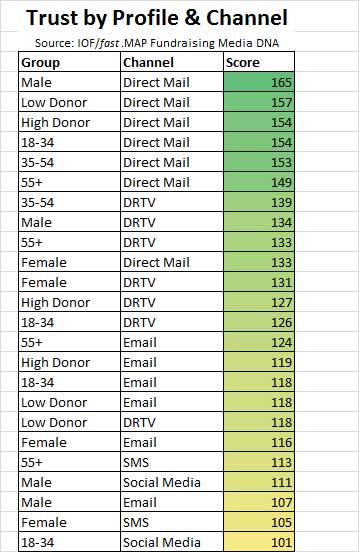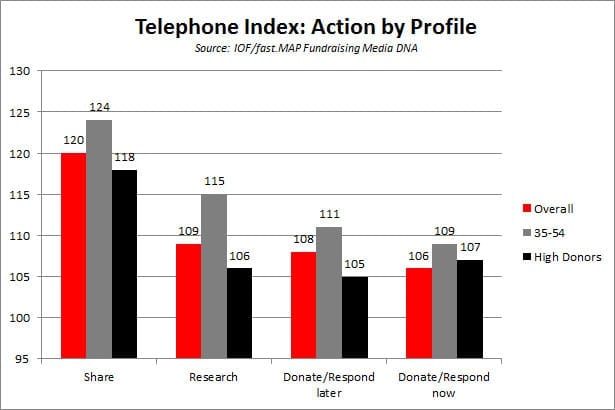Fundraising Media DNA: building trust in charities
Last month we shared the initial findings of Fundraising Media DNA, a new tracker survey undertaken by the Institute of Fundraising with charity research specialist fast.MAP. This month, in the first of a new series, we look in more detail about some of the first survey’s results.
What can fundraisers do to increase donor/ supporter/ prospect trust?
Fundraising Media DNA looks at eight key communication channels used for fundraising, providing insight about the relative strengths and advantages of each channel. This is broken down into three key areas:
• Profile – The people engaging with each channel
• Personality – What are the attributes associated with each channel
• Action – How people are likely to respond or act further as a result of the communication
The views of almost 2,500 consumers and over 130 fundraisers have been taken into consideration in the production of the report.
For each form of fundraising, fast.MAP took the responses of donors and fundraisers to build an index to give the results of the surveys. The average score will always be ‘100’, which provides the benchmark to compare the other scores. So, for example, a score of 250 on ‘Share’ means that it is performing at 2.5 times above the average score across that particular group.
Strongest channels for trust
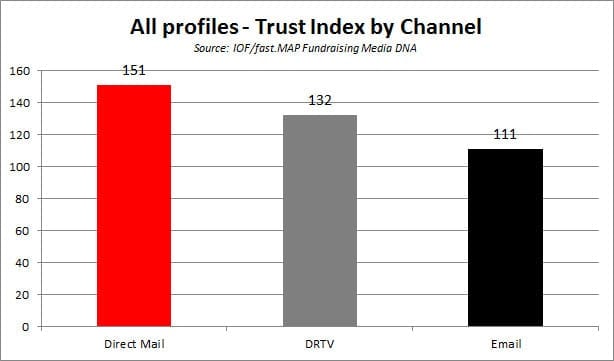
Direct mail is the most trusted fundraising channel
The three channels most likely to engender trust are direct mail (Overall Trust Index 151), DRTV (Overall Trust Index 132) and email (Overall Trust Index 111).
Scott Logie, MD, REaD Group Insight, commented:
Advertisement
“A crucial part for charities in building trust to supporters and potential donors is for causes to ensure they are communicating with them in their preferred channels. We can see this particularly with direct mail (Preferred Channel Index: 149) and email (Preferred Channel Index: 196).
“People are naturally more open to messages and requests in an environment they are comfortable with and enjoy engaging in. With the right approach, the right ask, at the right time, fundraisers can maximise the chances of raising funds for their important cause. It is also imperative for charities to ensure they build a database to communicate with people in a correct way for these preferences.”
Barney Hosey, MD, Brightsource, commented on the role of email:
“Email was in the top three most trusted channels across the majority of demographic profiles. Email has become an established communication channel for a very wide demographic; therefore it makes sense that charities increasingly incorporate email as part of the marketing mix to help build engagement and trust.
“It is important charities harness the supporting role that email can play in the mix. Using email to confirm or acknowledge an action is a great way of providing some kind of ‘proof’ for the donor that they are being kept up to date – crucial in building familiarity and trust. Trust and engagement can also be built by using email to amplify the impact of other channels – particularly direct mail, which is highlighted as the most trusted channel.”
Nairn Johnstone, Head of Data, Insight and Development, The Royal British Legion, explained why email was important to the charity, saying:
“Email is a channel that is easy to deliver a simplistic one size fits all with minor tweaks for personalisation. There is often little appetite to create different messaging beyond offering different products. This research has driven home the opportunity to target different supporter groups with radically different messaging.
“Groups who grew up with, or were late adopters of email have much more trust in the medium. Those who were early adopters to what was then a new channel went through the pain of the scams and spam is understandably less trusting. There is an opportunity to tweak our messaging to build trust in this audience and thus engagement in the charity and cause.
“Building and maintaining trust, now more than ever, is critical to any fundraising strategy. The ability to map the personality of channels will enable more effective supporter journey creation that goes beyond simply measuring ROI. Using a channel like email to pre-empt communication through a less trustworthy, but more personal, channel like Telephone should help charities engage in a more meaningful dialogue about their work.“
[youtube height=”450″ width=”800″]https://www.youtube.com/watch?v=tSf3sCE8RcI[/youtube]
Are channels universally trustworthy to all profiles?
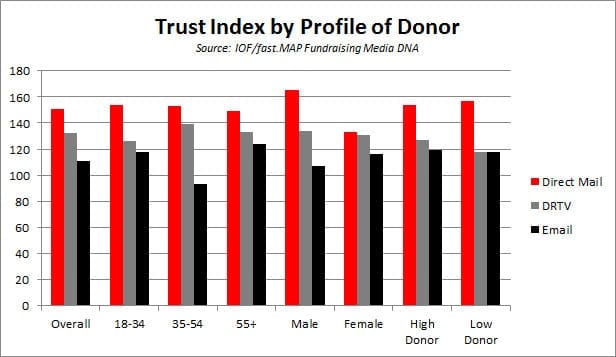
Direct mail, DRTV and email are also regarded as the more trustworthy channels by a variety of donors.
Some channels are seen as consistently trustworthy across all profiles. The favourites in order of trustworthiness are direct mail, DRTV and email. Direct mail achieved the highest trust index score of all channels and profiles among males (Trust Index 165).
Some channels are trusted more by some demographic groups than others. The SMS index among females is 105, while social media achieved an index of 101 among 18-34 year olds.
Graham Cooper, MD, ONEPOST, commented:
“As fundraisers and marketers, we know that direct mail is very appealing for charities looking to raise vital funds. We also know it is popular with older donors. However, we also have to acknowledge that 18-34s engage with it (Engagement Index: 18-34, 118) and that among 35-54s, it is also considered trustworthy too (Trustworthy Index: 35-54, 153).
“We should not underestimate the power of the printed word and the inherent qualities it has. That it is also relevant to people’s likes and dislikes (Relevant Index: 132), combined with the ability to target and personalise, means it is very efficient and powerful.”
Trust by profile and channel
What attributes are common within channels that are seen as being more trustworthy?
Both direct mail and email score particularly well for retainability, which suggests accountability is an important trust-building factor. People like to retain information for later reference. Direct mail achieves a high retainability score (overall index -155) as does email (overall index – 162).
Preference is personal, so some donors do not favour the channels which score best overall. DRTV is used as a direct response medium, but its mass-broadcast heritage means it is unlikely the messages it carries are perceived as a discrete individual communications in the same way as those using other direct marketing channels. However, it has authority (Authoritative Index: 137) which boosts results.
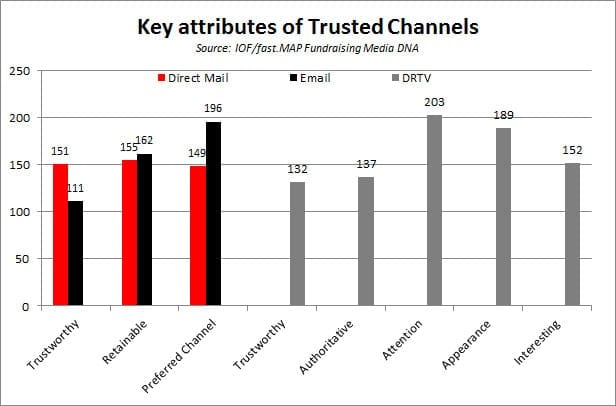
What makes a channel trusted?
Implications for charities
Supplementary material (which is often regarded by the recipient as accountable proof) can be integrated into campaigns. For example, street, door-to-door or phone campaigns can integrate leave-behind material or a follow-up message, to enhance credibility and trust.
A channel buddy-system. Some channels, such as telephone and door-to-door, are more likely to motivate action, but not score so well on trust.
By combining the most trusted media – direct mail, email and DRTV – with another channel such as telephone or street-fundraising (which are good at generating action), charities might maximise success through employing complementary channels. And a multi-channel approach can achieve a natural uplift by increasing exposure to the brand and the message.
If fundraisers communicate using a donor’s preferred medium, this helps to build trust. To do this it is necessary to obtain explicit channel choice when collecting consent-to-contact, as recommended in the latest Information Commissioners Office ICO guidelines.
David Cole, MD, fast.MAP, commented on the issue of trusted channels. He said:
“Fundraising campaigns work most effectively when a mix of media is used to enhance and underline the message, by extending the most appealing concept to the right audiences at the right time.
“Because people trust the messages carried via DRTV (Trustworthy Index: 132), direct mail (Index: 151) and email (Index: 111), savvy fundraising teams can use this goodwill to boost the credibility of co-ordinated promotions carrying the same message. By simultaneously using other channels to extend the campaign’s reach to include crucial target niches they can reinforce the message, boost brand reputation and uplift overall credibility.
“Also the tangible, personal qualities offered by print, when used in leave-behinds by door-to-door and street fundraisers or follow-up mailings/ emails after telephone appeals can compensate for those media’s lack of retainability.”
Justin Wylie, Head of Strategy, Performance and Insight, Action Aid, welcomed the detail on channel trust revealed by the survey. He said:
“These days charities need to maintain and rely upon a wide range of marketing channels and approaches. Across that portfolio, each channel has its own dynamics, personality, strengths and weaknesses, and that’s why ensuring a balanced portfolio is so critical for developing and establishing a sustainable and scalable fundraising strategy. There’s a rich body of data that can help us project out the returns we can expect from each channel. However, this new lens of looking at ‘trust by channel’ can only be a useful addition to that existing body of channel knowledge. It might firm up some of the assumptions we already had or help give us a broader understanding that we can act upon. The more insight, the better!”
Other findings
* All age groups trust both direct mail and DRTV – 18-34s, 35-54s, 55+
* Both direct mail and email generate equal levels of trust among both lower-value and higher-value donors
* Email is particularly trusted among 18-34s (Trust Index: 18-34, 118) – fundraisers were unaware a younger audience engaged with charities in this way (Engagement Index: 18-34, estimated by fundraisers: 84 vs. Actual 121)
* Those who give large donations have more trust in DRTV than those who donate less (Trust Index: High Donor 127 vs Low Donor 118)
* There is an inherent gravitas in DRTV (Authoritative Index: 137), indicating the medium can work well for charities of all sizes wishing to enhance supporter trust
* All of these factors, when combined with a focussed, appealing proposition, executed in a compelling way, can help charities generate vital funds for their cause
Detail on the fundraising channels
For more on the merits of these fundraising channels, download the summary infographics via the links below:
* The Fundraising Media DNA of Direct Mail
* The Fundraising Media DNA of DRTV
* The Fundraising Media DNA of Email
* Download the full Fundraising Media DNA report
* The second analysis in our series on the Fundraising Media DNA report will be published next month.




